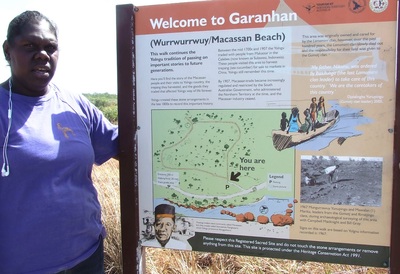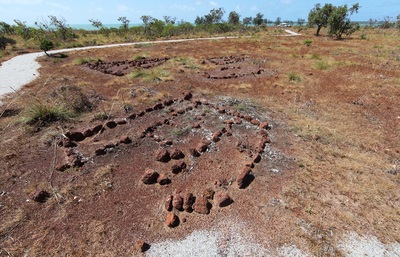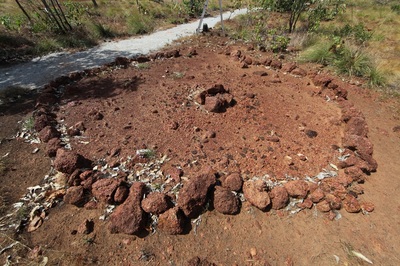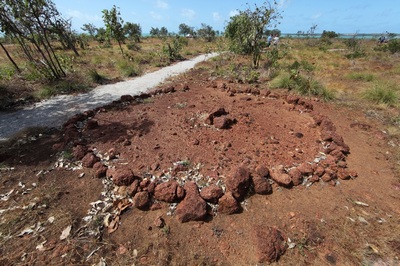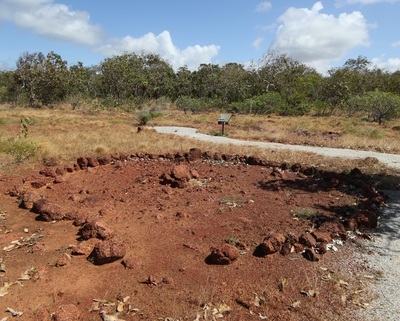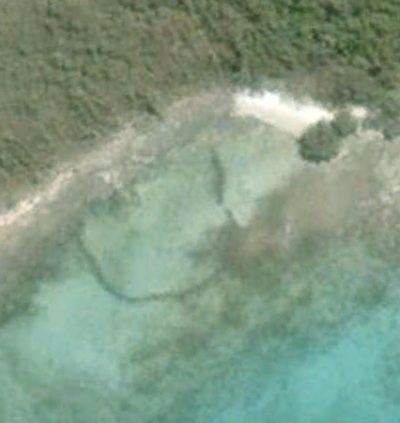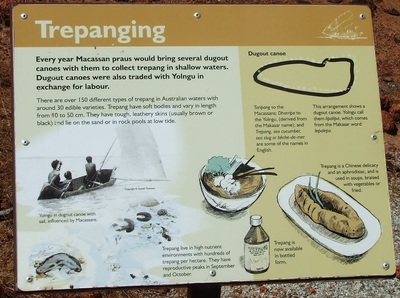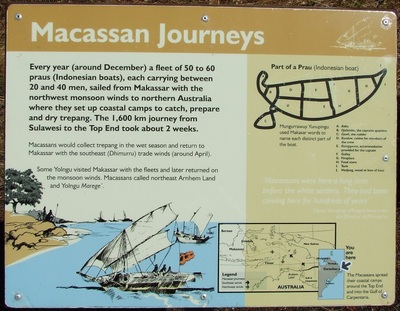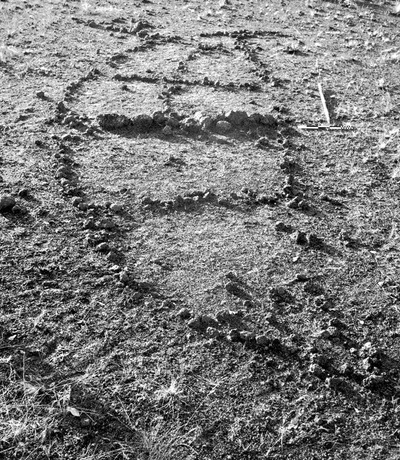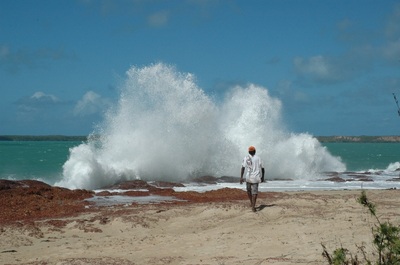WURRWURRWUY STONE PICTURES
 PastMasters 2013 expedition team & hosts at Wurrwurrwuy.
PastMasters 2013 expedition team & hosts at Wurrwurrwuy.
The PastMasters 2013 Ancient Coins in Arnhem Land Expedition team with our hosts the Dhimurru Rangers & traditional owners of the site on the Gove Peninsular, south of Nhulunbuy. The image is looking SE into the Gulf of Carpentaria with Cape Arnhem on the right horizon.
We had been asked to provide in-put to considerations of how best to conserve the pictures which are composed of bauxite that erodes readily and may be disturbed by wallabies, buffalo and cyclones.
The area has now been fenced by Dhimurru and pathways constructed to prevent buffalo & vehicle incursion. A specific issue is the proposal to replace some of the most badly degraded rock and we were able to confirm that this has been the practice in the past. As long as it done with reference to the historical images it is no worse than refreshing the masonry on a medieval sandstone cathedral.
The stone pictures were photographed and documented by Macknight & Bill Gray in 1970 and where possible their images are matched to current ones. High resolution aerial imagery is required to afford the perspective of the landscape which these artistic features populate and define. Many of the pictures are incomplete or overgrown and it is certain that there are many yet to be described. Perhaps these are landmarks of a trepang fleet journey from Makassar to the Wellesley Islands. It has been suggested that the arrangement has been constructed to represent a journey - in the same way as songline maps or spirit ancestor progresses such as those of the Wawilak Sisters. The interpretations & feature numbers are from Macknight & Gray whose informants were Mawalan Marika and Mungurrawuy Yunupingu whose forebears had created the pictures towards the end of the nineteenth century - when the trade was in terminal decline - so that future generations would know the Macassan story that is such an important part of their heritage. It is unquestionably Australia's earliest and longest lasting international trading relationship.
We had been asked to provide in-put to considerations of how best to conserve the pictures which are composed of bauxite that erodes readily and may be disturbed by wallabies, buffalo and cyclones.
The area has now been fenced by Dhimurru and pathways constructed to prevent buffalo & vehicle incursion. A specific issue is the proposal to replace some of the most badly degraded rock and we were able to confirm that this has been the practice in the past. As long as it done with reference to the historical images it is no worse than refreshing the masonry on a medieval sandstone cathedral.
The stone pictures were photographed and documented by Macknight & Bill Gray in 1970 and where possible their images are matched to current ones. High resolution aerial imagery is required to afford the perspective of the landscape which these artistic features populate and define. Many of the pictures are incomplete or overgrown and it is certain that there are many yet to be described. Perhaps these are landmarks of a trepang fleet journey from Makassar to the Wellesley Islands. It has been suggested that the arrangement has been constructed to represent a journey - in the same way as songline maps or spirit ancestor progresses such as those of the Wawilak Sisters. The interpretations & feature numbers are from Macknight & Gray whose informants were Mawalan Marika and Mungurrawuy Yunupingu whose forebears had created the pictures towards the end of the nineteenth century - when the trade was in terminal decline - so that future generations would know the Macassan story that is such an important part of their heritage. It is unquestionably Australia's earliest and longest lasting international trading relationship.
Macassans & the Trepang Trade

In 1803, prau master Pobassoo told Matthew Flinders that the Macassan trepang fleets had been coming to the Marege' Coast of Arnhem Land since approximately the 1770's which Campbell Macknight designates as the beginning of the industrial period, preceded by some decades of spot trade in turtle shell, pearls, hardwood and palm wax for candles. By the end of the nineteenth century, the trade was in precipitous decline and the introduction of taxation by the SA Government in late 1883 - partly to give advantage to potential Darwin based operators but also to mitigate against the increasing criticism that the Government was receiving about the Macassans corruption of Aboriginals with alcohol. Famous Territory identities were involved including Inspector Foelsche who accompanied Alfred Searcy & buffalo shooter turned Customs Officer E.O. Robinson who ran a Customs Post at Rolling Bay. A few families continued the seasonal trade and many Yolngu travelled to Sulawesi cementing a relationship that has survived the collapse of the trade in the 1906/07 season. Despite a rocky start with tit for tat massacres and periodic localised disputes over differing interpretations of what constitutes rental and purchase - the relationship between the Yolngu & Macassans bumped along to their mutual benefit despite the ravages of such as smallpox, yaws/syphilis. Today their influence is everywhere apparent.
It is certain that the Macassans were not the first visitors to NE Arnhem Land - not even the first visitors from Sulawesi. Prof. C.C. Macknight in Voyage to Marege writes "A factor of striking importance in the history of Southeast Asia has been the demand in distant markets for natural products found only or most abundantly in this region. Benjamin and camphor, dammar and sandalwood, clove and nutmeg, pepper and cubeb, butterflies and birds-of-paradise, have long been sought by the rich and powerful as much in the great empires of mainland Asia as in the farthest extremities of western Europe. The Chinese demand for trepang is only one aspect of this old and diverse trade." Macknight has done for Macassan research what Shakespeare did for iambic pentameter.
The Voyage to Marege' & Aboriginal Stone Pictures in Eastern Arnhem Land. Other resources include John Mulvaney - the Prehistory of Australia & Commandant of Solitude being Collett Barker's Diaries at Port Essington with Green - Searcy's works & articles - EO Robinson interview & Flinders V to TA - Mac's in the Gulf - Pobassoo Island & Cumberland Strait.} The Dhimurru website is excellent http://www.dhimurru.com.au/garanhan-stone-pictures.html & contains a great deal of information & images about the area & the people - they have produced a first rate Visitors Guide to the Recreation Areas of NE Arnhem Land.
It is certain that the Macassans were not the first visitors to NE Arnhem Land - not even the first visitors from Sulawesi. Prof. C.C. Macknight in Voyage to Marege writes "A factor of striking importance in the history of Southeast Asia has been the demand in distant markets for natural products found only or most abundantly in this region. Benjamin and camphor, dammar and sandalwood, clove and nutmeg, pepper and cubeb, butterflies and birds-of-paradise, have long been sought by the rich and powerful as much in the great empires of mainland Asia as in the farthest extremities of western Europe. The Chinese demand for trepang is only one aspect of this old and diverse trade." Macknight has done for Macassan research what Shakespeare did for iambic pentameter.
The Voyage to Marege' & Aboriginal Stone Pictures in Eastern Arnhem Land. Other resources include John Mulvaney - the Prehistory of Australia & Commandant of Solitude being Collett Barker's Diaries at Port Essington with Green - Searcy's works & articles - EO Robinson interview & Flinders V to TA - Mac's in the Gulf - Pobassoo Island & Cumberland Strait.} The Dhimurru website is excellent http://www.dhimurru.com.au/garanhan-stone-pictures.html & contains a great deal of information & images about the area & the people - they have produced a first rate Visitors Guide to the Recreation Areas of NE Arnhem Land.
